|
TRANSLATE THIS ARTICLE
Integral World: Exploring Theories of Everything
An independent forum for a critical discussion of the integral philosophy of Ken Wilber
 Marcel Cobussen studied jazz piano at the Conservatory of Rotterdam and Art and Cultural Studies at Erasmus University, Rotterdam. He currently teaches music philosophy and cultural theory at Leiden University (the Netherlands) and the Orpheus Institute in Ghent (Belgium).
Cobussen is author of the book Thresholds. Rethinking Spirituality Through Music (Ashgate, 2008), and co-author of Dionysos danst weer. Essays over hedendaagse muziekbeleving (Kok Agora, 1996). He is contributing editor of two special issues of the Dutch Journal of Music Theory, one on music and ethics (AUP, 2002) and one on artistic research (AUP, 2007), and edited a special issue of New Sound on improvisation (Belgrade, 2009). His Ph.D. dissertation Deconstruction in Music (2002) was presented as an online website located at www.cobussen.com. Marcel Cobussen studied jazz piano at the Conservatory of Rotterdam and Art and Cultural Studies at Erasmus University, Rotterdam. He currently teaches music philosophy and cultural theory at Leiden University (the Netherlands) and the Orpheus Institute in Ghent (Belgium).
Cobussen is author of the book Thresholds. Rethinking Spirituality Through Music (Ashgate, 2008), and co-author of Dionysos danst weer. Essays over hedendaagse muziekbeleving (Kok Agora, 1996). He is contributing editor of two special issues of the Dutch Journal of Music Theory, one on music and ethics (AUP, 2002) and one on artistic research (AUP, 2007), and edited a special issue of New Sound on improvisation (Belgrade, 2009). His Ph.D. dissertation Deconstruction in Music (2002) was presented as an online website located at www.cobussen.com.Defending the UncannyOn the Postmodern, the Art World,
|
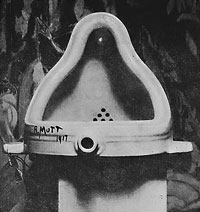
|
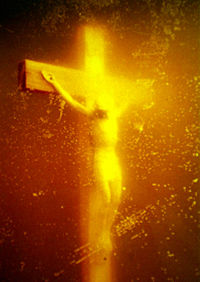
|
| "Fountain", Duchamp | "Piss Christ", Serrano |
What is Art?
Perhaps incautiously, I implicitly agreed with Lyotard, by using his exact words in the quote above and without immediately commenting upon them, that Duchamp and Buren are artists like Cezanne and the cubists. Implicitly I subscribed to Lyotard's conviction that Duchamp's Fountain, perhaps his most famous and controversial contribution to the art world, realized in 1917, is indeed a work of art. More than 90 years after its production, however, its status as an artwork still seems to be a subject under discussion:
“Is a signed toilet really art? If so, to whom, and for what reasons? What about a photograph of a crucifix sitting in urine [Serrano's Piss Christ] or menstrual fluids in beakers nailed to a wall – are these art?”
The (rhetorical) questions are from Keith Martin-Smith's 2008 essay “On the Future of Art and Art Criticism”. He continues:
Some of you will recall an “artist” who put fish into a blender, and invited passersby to blend them to smithereens. What about this? Is this art? It certainly sparked a lively debate about the topic that, by and large, only served to further confuse the issue for just everybody involved. I'll go ahead and answer it for once and for all: it's not art, not even to the postmodernist – it is, at best, a grotesque social commentary, a gimmick designed to make people reflect on some cultural ideas. But art? No, not even by the standards of postmodernism. (Martin-Smith, 2008, 11)
And a few pages further on:
“Is the Mona Lisa more beautiful than the aforementioned 'artist's' work of fish in blenders? Of course it is, unless your only standard for 'art' is 'controversy', in which case the mutilated fish are more 'beautiful'” (Martin-Smith, 2008, 13).
In my opinion, this seems to be a classical example of mixing two discussions. On the one hand, the question “what is art?”, whereby art should be understood in the classificatory sense. On the other hand, the question, “what is beauty (in art)?”, in a search for criteria on which aesthetic judgments and artistic quality can be based. To give an example, I am not convinced that “banging on a drum in a drunken fit is clearly not music”, as Martin-Smith states so firmly, though the odds are that it is not very good music. Of course, not all banging on a drum in a drunken fit is by definition music, but to exclude the possibility a priori is also dubious. Whether it is pleasant to listen to remains an open question dependent on many factors.
According to Martin-Smith's reasoning, Marcel Duchamp, Andres Serrano, and Marco Evaristti's works do not qualify as art because they “actually have no intrinsic beauty at all”. Now, it is of course everybody's right to create a kind of artistic or aesthetic hierarchy, to prefer one artwork over another, or to reject certain artworks because it is simply not to their taste. I would, however, hesitate to value some artworks more than others because of their “intrinsic beauty”. Beauty is perhaps not so much a feature of an object as it is a value judgment made by a subject in relation to an object or another subject. To claim that certain works “actually have no intrinsic beauty” furthermore runs the risk of becoming a dogmatic and even a totalitarian statement, especially when arguments are omitted and beauty is taken as an unproblematic qualification. In particular, modern art from the early twentieth century on (or is that postmodern art?) can hardly be adorned with the adjective “beautiful”. Russolo's futuristic noise-music, Bacon's paintings of misshapen faces or bodies, and Beckett's minimalist and deeply pessimistic theater plays are only three of the more well-known examples of so-called high art that cannot so easily be appreciated or judged in terms of beauty.
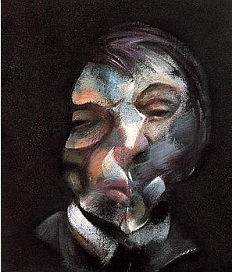
|
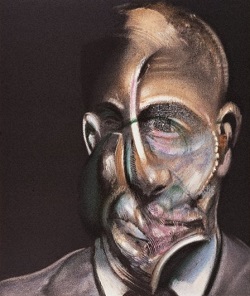
|
| "Self-Portrait", Francis Bacon | "Portrait of Michael Leiris", Francis Bacon |
These artworks are as much, or first of all, social and political statements, comments on both the field of culture and socio-political developments. Art cannot and should not be locked up in the vaults of current society; art and artists not only reflect (on) social events, they also co-create a society. Aesthetics and art cannot and should not be equated with beauty (though beauty can of course play an important role in the production of art as well as in aesthetical judgments).
Although I strongly disagree with the saying “there is no disputing about tastes” – to me a difference in aesthetic opinions might instigate a more fundamental discussion about quality judgments, the importance of art, its contribution to society – I would like to return to the question of whether Duchamp's Fountain should be considered as an artwork. Or in Martin-Smith's words: “Is it art or is it really something else?” What does “really” mean here? Do most people regard it as art but is it in fact not? Are we mistaken? Does Martin-Smith know something we do not know? Has he some access to truth, to The Truth? What is the position from which he can make such a sturdy statement? The way he presents his statement seems to be more of a definitive conclusion than the opening to a dialogue where an exchange of ideas might lead to new insights, although the concluding sentences of his essay are aiming at something else.
What is art? Or perhaps a better question: who decides what art is and what not? The latter implicitly questions the ontological, perpetual, and ubiquitous status of the category “art”. It emphasizes that art is a total social fact: to call something an artwork is a relational matter, a cultural, social, political, and institutional decision made by humans.
As early as 1964, the American philosopher Arthur Danto wrote that “to see something as art requires something the eye cannot descry – an atmosphere of artistic theory, a knowledge of the history of art: an artworld” (Danto, 1964, 580). Reacting to works such as Duchamp's Fountain and Andy Warhol's Brillo – showing no trace of the artist, either in skill or in intention, but nevertheless renowned in the world of contemporary visual arts – Danto concluded that the artistic character and quality of these works had to be placed outside the physical object itself. Instead, their qualities had to be found in the relation of these objects to an existing art world, to the organizations in which art was produced, distributed, appreciated, and discussed (Becker, 1982, 146). A conclusion that could be drawn from Becker's remarks is that there are no constraints on the nature of an object or event itself which make certain objects ipso facto not art. This does not mean, however, that everything is thereby art; not every attempt to label something as art is successful. The constraints arise from a prior consensus – in most cases by trained and experienced members of the art world, we could call it the art forum – on what kinds of standards will be applied. And since the degree of consensus about who can decide what art is varies greatly from one situation to another, the question whether or not an object or event is art should be considered a continuous variable rather than an all-or-nothing dichotomy (Becker, 1982, 152-5).
Usually, these representatives of the art world base their opinion about a “candidate for appreciation,” as George Dickie expressed it (see Becker, 1982, 149), their decision to call something an artwork, on past developments. History has passed down an interminable number of works that are already classified as art. Part of the decision is thus based on a comparison with what has gone before: is the “candidate” an acceptable continuation of this bygone corpus? Answering this question is thus no matter of subjective capriciousness but of intersubjective interactions with former forums. Thus, intersubjectivity not only manifests itself in the art forum but also diachronically: contemporary decisions are influenced by past decisions made by previous members of the art forum.
Dealing with the issue of whether something is an artwork is also influenced by a “sideward look”: it says something about the prevailing systems of classifying cultural products, about the present, about the contemporary organization of the society in which the candidate has to find its place. Deciding that the candidate is indeed an artwork thus (also) implies that it does not primarily belong to science, technology, religion, politics, sport, etc. Finally, regarding an object or event as art also means to ascribe to that object or event a role in the progress of art; it contributes to what is not there yet (future art). According to different forums, Duchamp, Warhol, Serrano, Evaristti and so many others somehow fit into these relatively autonomous developments of the past, present, and future art world.
The increasing fragmentation and specialization of (mostly Western) societies from the end of the nineteenth century on (Welsch, 1988, 78-9) also left its traces in the art world. Let's take the music world as an example this time. If, as Robert Morgan claims, there ever existed a coherent and well-formed musical language in the Western world, based upon commonly shared formal and expressive assumptions, a common core or grammar, a system of relatively stable constructing principles despite all stylistic heterogeneity, then this language has been seriously undermined by musical developments during the twentieth century (Morgan, 1992, 44-6). Morgan specifically mentions the emancipation of noise and the application of any sonic material as a musical ingredient, eclecticism and the use of quotations, and the omnipresence of all kinds of music, owing to mass media as well as broad programming. The result of this pluralistic cast of contemporary musical life is that our musical culture is no longer a single, relatively focused entity, but a mélange of conflicting subcultures.
These subcultures cannot be viewed simply as satellites of a central culture; taken collectively, they are starting to constitute that culture themselves (Morgan, 1992, 57). In Deleuzian terms, musical culture has moved from an arborescent to a rhizomatic system. In a way, the music world gives voice to Lyotard's ideas about the decline of so-called “grand narratives” in favor of local and temporary stories or frameworks. Instead of being a homogeneous whole, the music world allows for high levels of diversity and instability, thus questioning the hegemony of a relatively small and limited body of music in setting absolute standards of acceptability (Morgan, 1992, 59). Music is no longer exclusively measured against an absolute standard of “high” art, a conclusion that seems to undermine the idea of a canon: when all music becomes equally acceptable, then all standards become equally irrelevant. A similar fear crops up in Martin-Smith's essay when he accuses “deconstructive postmodernism” of criticizing the way things are usually valued, leaving them in an undifferentiated heap of “everything/anything is as good as everything else” (Martin-Smith, 2008, 8).
However, instead of one amorphous, all-encompassing canon, Morgan observes the rise of a set of multiple canons, alternative canonic models for alternative subcultures.
Ideally, this framework would produce a culture of tolerance and broad understanding, but one in which differences still mattered and standards of excellence still applied. Under such circumstances a pluralistic musical culture could flourish, offering adequate provisions for different and divergent lines of development; yet a place would be preserved for evaluative criteria. The latter would not be immutable laws, of course, but would vary with time. (Morgan, 1992, 61)
What should have become clear from this elaboration is, first, that the decision about a “candidate for appreciation” is not fully in the hands of one art forum, a kind of central committee. Each artistic subculture has it own forum or forums. This is almost self-evident in the case of different artistic disciplines: the art forum dealing with plastic arts of course differs from the music, theater, or dance forum (though overlap is of course possible). Actually, however, this network of forums has a far more intricate structure: within the music world there are forums for classical, rock, jazz, and world music and, for example, within the jazz world different forums will deal with mainstream jazz, swing, free improvised music, jazz dance, etc.
Second, each subculture thus has its own grammatical norms and with them an idea about the quality of a certain candidate. Of course this is far removed from the idea of expressing once and for all the truth about either the status of an object or event (whether it is an artwork or not) or the value that can be attributed to that object. Subcultures and the decisions made there are unstable, temporary, and the results of a provisional consensus. This, however, is almost the opposite of the idea, often expressed by explicit opponents of the postmodern, that in contemporary culture or art “anything goes” or that every judgment of taste has become purely subjective.
From Integralism to Complexity
Now, the image that might arise from the above is that the (art) world has moved towards more complexity, a statement confirmed by many scientists, by the way. (See for example M. Mitchell Waldrop's book Complexity.) This doesn't necessarily mean that art “in itself” has become more complex or that it should be. (Why would the complex music of Brian Ferneyhough deserve to be viewed with greater care and with greater value than the relatively simple music of Neil Young? Even if complexity in art is described as the huge internalized knowledge of an artist, I am not sure if that would make one artwork better than another. Taking into account Roland Barthes's essay “The Death of the Author” as well as Hans-Georg Gadamer's hermeneutics, an artwork should be judged on its own merits instead of on the professional background of its maker.)
Complexity, however, means, for example, that the production, distribution, and reception of art cannot be plotted any longer on a simple linear line from artist to audience. It means that we can no longer take for granted that, in the musical domain, a composer is the person who performs the core activity, inhabiting the innermost circle surrounded by other circles (more or less successively) in which the performers, the manufacturers and distributors of the materials needed to produce a musical work, other support personnel like technicians, audience, people providing an aesthetic rationale, teachers and trainers, and others taking care of civic order such that people engaged in making music can count on a certain stability, can be located (Becker, 1982, 2–5; Cobussen, 2009). Although Becker acknowledges, however, that the status of any particular activity as a core activity might change (think of the role of DJs, MCs, and producers), he holds on to a hierarchical ordering of an art world in which the artist at all times occupies the most prominent position.
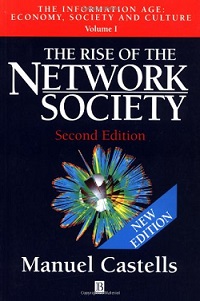
Instead of Becker's “circle model” I see more good in the idea of the art world as a network, a network as presented, for example, in Manuel Castells's The Rise of the Network Society. According to Castells, a network is a set of interconnected nodes, an architecture that cannot be controlled from any center. Instead of Becker's two-dimensional, more or less stable image of an art world, a multi-dimensional dynamic idea of the art world seems to be more realistic these days. In the musical world the actors at work in and during the musical process – actors including musicians, listeners, and support personnel but also instruments, technology, acoustics, musical backgrounds, styles, corporeality, memory, etc. – contribute, each time differently, with varying impact and importance, in a complex web of relations and interactions. In other words, not only is the center of an artistic process variable, usually there is not one center from which everything starts: the interactions that take place during an artistic process are many and many-sided and not necessarily orchestrated from one central point. With almost every process the composition and configuration of this network change. The artistic network is a multiplicity.
Thinking networks means thinking open structures that can expand endlessly. If integralism means “being an essential part of something; without missing parts or elements” (Martin-Smith, 2008, 12), then there seems to be a fundamental difference between integralism and the concept of complexity. It is here that I join with the idea of assemblages as developed by Gilles Deleuze, Félix Guattari, and, later, Manuel DeLanda. Following these thinkers, I do not regard the art world (and in fact social reality as a whole) as a collection of separate elements, like the parts of a do-it-yourself kit, which can form a fixed and immovable whole. Contrary to this kind of “system thinking”, an assemblage combines heterogeneous elements. The unity thus constructed is no indivisible substance but an unlimited surface on which a play of relations takes place without hierarchy, transcendence, eternity, or stable order.
Complex systems like the art world cannot be reduced to their components; their functioning is situated in the relations between the components or agents that are part of these complexities, these assemblages. As these relations are independent of and external to the separate agents, their positions cannot be narrowed down to essentials or regarded as parts of a whole. The characteristics of the agents cannot elucidate the relations which give the system its form and content; relations can change without the agents changing.
The difference between the idea of a complex system and a totality is that in the latter the linkage between its components forms logically necessary relations which make the whole what it is. In a complex system, on the other hand, these relations may be only contingently obligatory (DeLanda, 2006, 11).
For this reason, the ontological status of a complexity is always that of unique singular agents and their interrelations. Unlike any form of essentialism, the ontology of a complex system is flat since it contains nothing but differently scaled individual singularities (DeLanda, 2006, 28).
To conclude, being “contingently obligatory” instead of “logically necessary” means that an agent can detach him/herself relatively in order to start functioning in another complexity or assemblage. This new context, for its part, is formed by new variables and unanticipated interactions. That way, a complexity escapes from models in which order and unity presuppose each other.
In my opinion, the art world can be called an assemblage in the sense that it is an open system. Only concentrating on the human agents, Dickie describes that art world as
A loosely organized but nevertheless related set of persons including artists …, producers, museum directors, museum-goers, theater-goers, reporters for newspapers, critics for publications of all sorts, art historians, art theorists, philosophers of art, and others. These are the people who keep the machinery of the artworld working and thereby provide for its continuing existence … In addition, every person who sees himself as a member of the artworld is thereby a member. (Dickie quoted in Becker, 1982, 150)
In general, it is hard to demarcate the exact boundaries and limits of the art world as an institution. More particularly, it might be possible to map the actors, factors, and vectors at work in a specific art production. However, as stated before, not all of them determine every artistic event to the same extent; in certain situations (periods, styles, cultures as well as more singular circumstances), some are more prominent and active than others. Therefore, the complexity theories cannot be theories dealing with art “in general”. They should emphasize singularity: each artistic production will yield a different network of agents and interactions, a different configuration and a different assembly.
With these concluding remarks I am back at the beginning of this essay, back at the “postmodern” conviction that thinking generalizations, thinking stable and eternal definitions, thinking linearity, and thinking hierarchical order, are, as yet, past history. Pace integralism.
Literature
Becker, Howard S., Art Worlds (Berkeley: University of California Press, 1982).
Castells, Manuel, The Rise of the Network Society (Cambridge (MA): Blackwell Publishers, 1996).
Cobussen, Marcel, “The Field of Musical Improvisation,” Konturen 1, 2 (2009). http://konturen.uoregon.edu/volume2.html#
Danto, Arthur C., “The Artworld”, Journal of Philosophy 61 (1964: 571-84).
DeLanda, Manuel, A New Philosophy of Society. Assemblage Theory and Social Complexity (New York: Continuum, 2006).
Deleuze, Gilles and Guattari, Félix, A Thousand Plateaus (Minneapolis: University of Minnesota Press, 1987).
Derrida, Jacques, Dissemination, trans. B. Johnson (Chicago: University of Chicago Press, 1981).
Derrida, Jacques, “Letter to a Japanese Friend”, in: Wood, D. and Bernasconi, R. (eds.) Derrida and Différance (Evanston: Northwestern University Press, 1988: 1-5).
Foucault, Michel, “What is Enlightenment?”, in: Rabinow, P. (ed) The Foucault Reader (London: Penguin Books, 1981: 32-50).
Lyotard, Jean-François, The Postmodern Condition, trans. G. Bennington and B. Massumi (Minneapolis: University of Minnesota Press, 1984).
Lyotard, Jean-François, Immaterialität und Postmoderne. (Berlijn: Merve Verlag, 1985).
Lyotard, Jean-François, The Inhuman. Reflections on Time, trans. G. Bennington and R. Bowlby (Cambridge: Polity Press, 1991).
Lyotard, Jean-François, The Postmodern Explained: Correspondence 1982-1985, trans. and eds J. Pefanis, M. Thomas, and D. Barry (Minneapolis: University of Minnesota Press, 1993).
Martin-Smith, Keith, “On the Future of Art and Art Criticism” (2008). (http://www.integralworld.net/martin-smith2.html).
Morgan, Robert, “Rethinking Musical Culture: Canonic Reformulations in a Post-Tonal Age”, in: Bergeron, K. & Bohlman, P., Disciplining Music. Musicology and Its Canons. (Chicago: University of Chicago Press, 1992: 44-63).
Taylor, Mark C., Erring: a Postmodern A/theology (Chicago: University of Chicago Press, 1984).
Waldrop, M. Mitchell, Complexity. The Emerging Science at the Edge of Order and Chaos (New York: Touchstone, 1992).
Welsch, Wolfgang, Unsere postmoderne Moderne (Weinheim, Germany: VCH, Acta Humaniora, 1988).